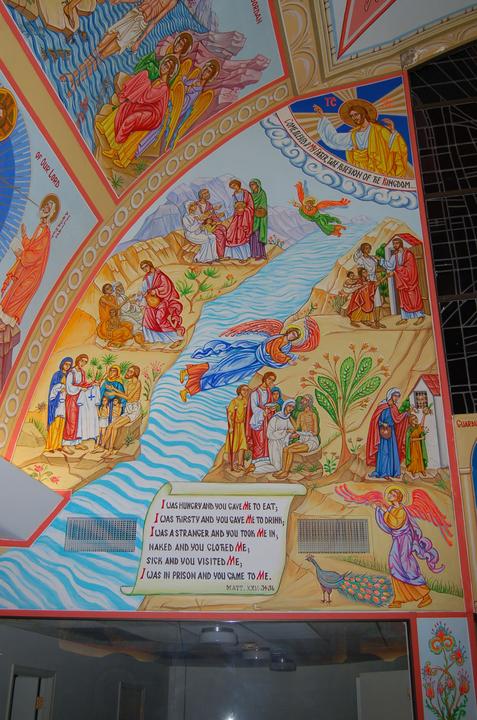Byzantine iconography sees the church as a microcosm of heaven and earth, united through the divine economy of salvation… 
At the highest point of the dome-like ceiling there is the monumental icon of Christ – Pantocrator (upholder of all creation). He is the apocalyptic Alpha and Omega. Also, high above the place where the faithful receive communion hangs the icon of the Rublev Old Testament Trinity, representing the moment when the Holy Trinity decided through the incarnation of the Second Person to begin the salvation of the human race.

At the back of the sanctuary is the mystical communion of the apostles: Christ nourishing his Church with his eucharistic body and blood. This scene is filled out on either side by the great fathers of the Church.


The back wall is dedicated to the final things: the dread judgment and heaven and hell.

 In the curved part of the apse is depicted the Blessed Mother of the Sign with arms outstretched in prayer for all her children.
In the curved part of the apse is depicted the Blessed Mother of the Sign with arms outstretched in prayer for all her children.
 High on the side walls in two rows are the major feasts of the Church, while lower down are the great women saints – left side, and the great men saints — right side. (In Byzantine churches in Europe and the Middle East, women and girls traditionally stand on the left and men and boys on the right.)
High on the side walls in two rows are the major feasts of the Church, while lower down are the great women saints – left side, and the great men saints — right side. (In Byzantine churches in Europe and the Middle East, women and girls traditionally stand on the left and men and boys on the right.)  The whole ensemble is united by skirting, representing the wedding feast of the Lamb and his Church, of which Byzantine worship is a foretaste.
The whole ensemble is united by skirting, representing the wedding feast of the Lamb and his Church, of which Byzantine worship is a foretaste. 
 The iconostasis that separates the altar area from the nave of the church has four great icons: These are read from left to right: St. John the Baptist, who points to the Lamb who takes away the sin of the world, the Blessed Mother holding the Christ Child, Christ the Teacher, and the patronal icon of the church, namely, the icon of the Ascension. The royal doors of the iconostasis show the scene of the Annunciation with the archangel Gabriel announcing to the Blessed Virgin that she will become the mother of the Savior. The two deacons’ doors depict the holy archangels Michael and Raphael, representing, respectively, victory over evil and divine healing.
The iconostasis that separates the altar area from the nave of the church has four great icons: These are read from left to right: St. John the Baptist, who points to the Lamb who takes away the sin of the world, the Blessed Mother holding the Christ Child, Christ the Teacher, and the patronal icon of the church, namely, the icon of the Ascension. The royal doors of the iconostasis show the scene of the Annunciation with the archangel Gabriel announcing to the Blessed Virgin that she will become the mother of the Savior. The two deacons’ doors depict the holy archangels Michael and Raphael, representing, respectively, victory over evil and divine healing.



